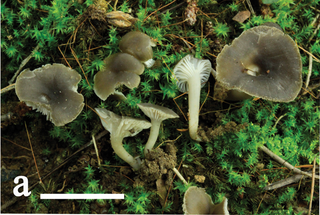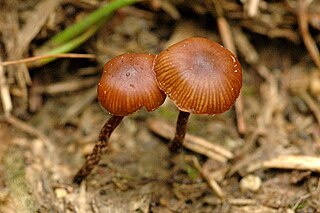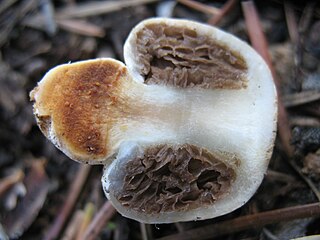Related Research Articles

Rolf Singer was a German-born mycologist and one of the most important taxonomists of gilled mushrooms (agarics) in the 20th century.

Camarophyllopsis is a genus of agarics in the family Clavariaceae. Basidiocarps are dull-coloured and have dry caps, rather distant, decurrent lamellae, white spores, and smooth, ringless stems. In Europe species are characteristic of old, unimproved grasslands which are a declining habitat, making them of conservation concern.

The genus Stropharia is a group of medium to large agarics with a distinct membranous ring on the stipe. Well-known members of this genus include the edible Stropharia rugosoannulata and the blue-green verdigris agarics. Stropharia are not generally regarded as good to eat and there are doubts over the edibility of several species. However the species Stropharia rugosoannulata is regarded as prized and delicious when young, and is now the premier mushroom for outdoor bed culture by mycophiles in temperate climates.
Gastón Guzmán Huerta, a Mexican mycologist and anthropologist, was an authority on the genus Psilocybe.

Phaeocollybia is a genus of fungi in the family Hymenogastraceae. They are characterized by producing fruit bodies (mushrooms) with umbonate caps and rough brown spores. The genus is widely distributed, and contains about 50 species. They are known for a long stipe which continues down into the ground, known as a rooting stipe or pseudorhiza formed as the fruitbody grows up from the subterranean colonized roots well below the organic soil layer. The genus is primarily mycorrhizal but may also be somewhat parasitic on forest trees.

Crepidotus is a genus of fungi in the family Crepidotaceae. Species of Crepidotus all have small, convex to fan-shaped sessile caps and grow on wood or plant debris. The genus has been studied extensively, and monographs of the North American, European and Neotropical species have been published.

Pseudoomphalina is a genus of fungi in the placed in the family Tricholomataceae for convenience. The genus contains six species that are widespread in northern temperate areas. Pseudoomphalina was circumscribed by Rolf Singer in 1956. Pseudoomphalina was found to be paraphyletic to Neohygrophorus in a molecular phylogenetics study and since Pseudoomphalina is an older name, Neohygrophyorus was synonymized with it. The type species of Neohygrophorus was Neohygrophorus angelesianus, now Pseudoomphalina angelesiana. In earlier classifications based on anatomy prior to DNA sequence-based classifications, its unusual combination of features led taxonomists to independently create two subgenera in two genera: Hygrophorus subg. Pseudohygrophorus and Clitocybe subg. Mutabiles; the latter based on Neohygrophorus angelesianus but described under a new species name which is now placed in synonymy, Clitocybe mutabilis. All species of Pseudoomphalina are united by the presence of clamp-connections in their hyphae, an interwoven gill trama and amyloid spores. Pseudoomphalina angelesiana possesses grey-violaceous pigments that turn red in alkali solutions and lacks filiform, hyphal sterile elements in its hymenium and stipitipellis. These were features used to distinguish it from Pseudoomphalina as a genus, but Pseudoomphalina umbrinopurpurascens possesses these same pigments and the filiform elements of Pseudoomphalina. Molecular phylogenetics studies have also found some former species of Pseudoomphalina to belong in other genera. Pseudoomphalina pachyphylla was moved to its own genus, Pseudolaccaria, and Pseudoomphalina clusiliformis was synonymized with it. Pseudoomphalina flavoaurantia and Pseudoomphalina lignicola were found to belong in Clitocybula. Phylogenetically, Pseudoomphalina is in a tricholomatoid clade but not in the Tricholomataceae.

Meinhard Michael Moser was an Austrian mycologist. His work principally concerned the taxonomy, chemistry, and toxicity of the gilled mushrooms (Agaricales), especially those of the genus Cortinarius, and the ecology of ectomycorrhizal relationships. His contributions to the Kleine Kryptogamenflora von Mitteleuropa series of mycological guidebooks were well regarded and widely used. In particular, his 1953 Blätter- und Bauchpilze [The Gilled and Gasteroid Fungi ], which became known as simply "Moser", saw several editions in both the original German and in translation. Other important works included a 1960 monograph on the genus Phlegmacium and a 1975 study of members of Cortinarius, Dermocybe, and Stephanopus in South America, co-authored with the mycologist Egon Horak.

Deconica is a genus of mushroom-forming fungi in the family Strophariaceae. It was formerly considered synonymous with Psilocybe until molecular studies showed that genus to be polyphyletic, made of two major clades: one containing bluing, hallucinogenic species, the other non-bluing and non-hallucinogenic species. Deconica contains species formerly classified in the sections Deconica and Coprophila of Psilocybe.

Nivatogastrium is a genus of secotioid fungi in the family Strophariaceae. The genus has contained four species found in North America and New Zealand, but the type species, Nivatogastrium nubigenum, is now considered to be a gasteroid species of Pholiota, and was transferred to that genus in 2014.
Egon Horak is an Austrian mycologist who has described more than 1000 species of fungi, including many from the Southern Hemisphere, particularly New Zealand and South America. He was an executive editor of the scientific journal Sydowia from 1975 to 1989, and a member of the editorial board afterwards.
Phaeocollybia herrerae is a species of fungus in the family Cortinariaceae. Found in Morelos, Mexico, where it grows in subtropical (mesophytic) forest with oak and in pine-oak forest, it was described as new to science in 1996 by mycologists Victor Bandala and Leticia Montoya. It is in the section Microsporae of genus Phaeocollybia. Its roughly ellipsoid to somewhat egg-shaped spores measure 5–5.5 by 2.5–3 µm. The specific epithet herrerae honors Teófilo Herrera Suárez, "because of his prominent contribution to Mexican mycology 50 year ago".
Phaeocollybia amygdalospora is a species of fungus in the family Cortinariaceae. Found in Durango, Mexico, where it grows under pine, it was described as new to science in 1996 by mycologists Victor Bandala and Egon Horak. It has amygdaliform (almond-shaped) spores that measure 6.5–9 by 4–5 µm.
Phaeocollybia moseri is a species of fungus in the family Cortinariaceae. Found in Chiapas, Mexico, where it grows under pine, it was described as new to science in 1996 by Victor Bandala and Gastón Guzmán. It belongs to the section Versicolores of the genus Phaeocollybia. The specific epithet moseri honors Dutch mycologist Meinhard Moser, "on the occasion of his 70th anniversary and for his contribution to agaric systematics".
References
- 1 2 Singer R. (1962). "Diagnoses fungorum novorum Agaricalium II". Sydowia. 15 (1–6): 45–83.
- 1 2 3 Horak E, Halling RE (1991). "New records of Phaeocollybia from Colombia" . Mycologia. 83 (4): 464–72. doi:10.2307/3760357. JSTOR 3760357.
- 1 2 3 4 5 Norvell L. (2000). "Phaeocollybia in Western North America 1: The Phaeocollybia kauffmanii complex". Canadian Journal of Botany. 78 (8): 1055–76. doi:10.1139/b00-082.
- 1 2 3 4 Bandala VM, Montoya L, Guzmán G, Horak E (1996). "Four new species of Phaeocollybia". Mycological Research. 100 (2): 239–43. doi:10.1016/S0953-7562(96)80130-4.
- ↑ Bon M. (1978). "Tricholomataceae de France et d'Europe occidentale - 5 - (Sous-famille Leucopaxilloideae (Singer) Bon)". Documents Mycologiques (in French). 9 (33): 1–79.
- 1 2 3 Singer R. (1949). "The Agaricales in modern taxonomy". Lilloa. 22 (2): 567.
- 1 2 Rees BJ, Wood AE (1996). "The genus Phaeocollybia in south-eastern Australia". Mycotaxon. 57: 97–116.
- 1 2 3 4 5 6 7 8 9 10 11 12 13 Horak E. (1977). "Further additions towards a monograph of Phaeocollybia". Sydowia. 29 (1–6): 28–70.
- 1 2 3 4 5 6 7 Singer R. (1987). "Phaeocollybia in the oak woods of Costa Rica, with notes on extralimital taxa". Mycologia Helvetica. 2 (2): 247–66.
- 1 2 3 4 5 6 7 Smith AH (1957). "A contribution towards a monograph of Phaeocollybia". Brittonia. 9 (4): 195–217. Bibcode:1957Britt...9..195S. doi:10.2307/2804723. JSTOR 2804723. S2CID 43785035.
- ↑ Redhead SA, Norvell LL (1993). "Phaeocollybia in Western Canada". Mycotaxon. 46: 343–58.
- 1 2 Heim R. (1931). "Le genre Inocybe". Encyclopédie Mycologique (in French). 1: 71.
- 1 2 3 4 Romagnesi H. (1944). "Description de quelques espèces d'agarics ochrosporés. II. Sur quelques Naucoria". Bulletin de la Société Mycologique de France (in French). 58: 121–49.
- ↑ Singer R. (1970). "Phaeocollybia (Cortinariaceae-Basidiomycetes)". Flora Neotropica. 4: 1–13. JSTOR 4393665.
- ↑ Horak E. (1980). "Indian Boletales and Agaricales. Revisions and new taxa". Sydowia. 33: 88–110.
- ↑ Heim R. (1942). Bulletin Trimestriel de la Société Mycologique de France (in French). 58: 127.
{{cite journal}}: Missing or empty|title=(help) - ↑ Rees BJ, Syme K (1999). "A new species of Phaeocollybia from Western Australia" (PDF). Australasian Mycologist. 18 (1): 5–9.[ permanent dead link ]
- 1 2 3 4 Smith AH, Trappe JM (1972). "The higher fungi of Oregon's Cascade Head Experimental Forest and vicinity – I. The genus Phaeocollybia (Agaricales) and notes and descriptions of other species in the Agaricales". Mycologia. 64 (5): 1138–53. doi:10.2307/3758079. JSTOR 3758079.
- 1 2 Bandala-Muñoz VM, Montoya L (1994). "Further investigations on Phaeocollybia with notes on infrageneric classification". Mycotaxon. 52 (2): 397–422.
- ↑ Singer R. (1940). "Notes sur quelques Basidiomycètes". Revue de Mycologie (in French). 5: 3–13.
- 1 2 3 Bandala-Muñoz VM, Guzmán G, Montoya-Bello L (1989). "Additions to the knowledge of Phaeocollybia (Agaricales, Cortinariaceae) from Mexico, with description of new species". Mycotaxon. 35 (1): 127–52.
- 1 2 3 Horak E. (1973). "Fungi agaricini Novaezelandiae I-V". Beihefte zur Nova Hedwigia. 43: 188.
- ↑ Halling RE, Horak E (2008). "Phaeocollybia longistipitata sp. nov. from Costa Rica". North American Fungi. 3 (7): 177–85. doi: 10.2509/naf2008.003.00711 .
- ↑ Singer R. (1986). The Agaricales in Modern Taxonomy (4th ed.). Königstein im Taunus, Germany: Koeltz Scientific Books. p. 665. ISBN 978-3-87429-254-2.
- ↑ Coimbra VRM, Gibertoni TB, Wartchow P (2012). "Phaeocollybia nigripes (Agaricomycetes), a new species from Brazil". Mycotaxon. 120: 171–9. doi: 10.5248/120.171 .
- ↑ Norvell LN, Exeter RL (2007). "Phaeocollybia in western North America 5: P. ochraceocana sp. nov. and the P. kauffmanii complex". Mycotaxon. 102: 315–32.
- 1 2 Norvell LL (2002). "Phaeocollybia in western North America 3: Two new species with notes on the Phaeocollybia festiva complex". Mycotaxon. 81: 95–112.
- ↑ Wei TZ, Fu SZ, Qu PP, Yao YJ (2010). "Phaeocollybia purpurea (Cortinariaceae), a new species from Wuyishan, China". Mycotaxon. 113: 423–30. doi: 10.5248/113.423 .
- 1 2 Horak E. (1974). "Two new species of Phaeocollybia (Agaricales, Fungi) from India". Acta Botanica Indica. 2 (1): 69–73.
- ↑ Bigelow HE, Barr ME (1963). "Contribution to the fungus flora of north-eastern North America. III". Rhodora. 65 (764): 289–309.
- 1 2 Norvell LL (2004). "Phaeocollybia in western North America 4: Two new species with tibiiform cheilocystidia and Section Versicolores reconsidered". Mycotaxon. 90 (2): 241–60.
- ↑ Liu PG (1995). "Five new species of Agaricales from southern and southeastern Yunnan, China". Mycotaxon. 56: 89–105.